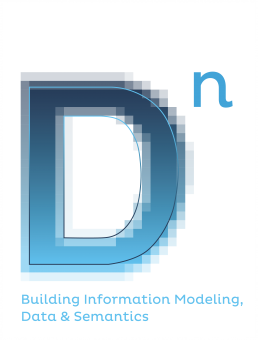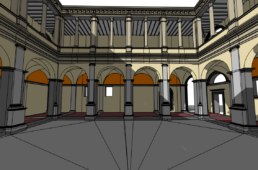Digital models for built heritage representation and management
ABSTRACT
In the last decade, digital processes have strongly influenced the ways in which information concerning the built heritage is represented and managed and the consequent preservation and enhancement activities conducted by specialists in the field. While this has led to a significant increase in the amount of data produced, equally evident are the difficulties encountered in archiving and managing this knowledge, with consequent loss of data and dispersion of memory related to the design and construction of historic buildings. This paper aims to illustrate the potential that a model-based approach can offer for representing the multifaceted richness and uniqueness of the architectural heriatage, both from a material and intangible point of view, thus acting as a conduit for the knowledge and memory of the craftsmen who built it.
Stefano Cursi, Letizia Martinelli, Filippo Calcerano, Michele Calvano, Luciano Cessari, Elena Gigliarelli
ISPC Istituto di Scienze del Patrimonio Culturale, Consiglio Nazionale delle Ricerche
Artificial Intelligence, H-BIM and collaborative reality-based platforms for the annotation of digital architectural heritage
ABSTRACT
This paper summarizes the results of a Ph.D. thesis, conducted on the combination of Artificial Intelligence, H-BIM and collaborative reality-based platforms for the transfer and retrieval of semantic annotations on digital cultural heritage, in support of restoration and conservation processes.
Valeria Croce
Dipartimento di Ingegneria dell’Energia, dei Sistemi, del Territorio e delle Costruzioni, University of Pisa
Editorial Vol. 10
The 10th issue of the journal collects the best contributions of the WORKSHOP 3D MODELING & BIM 2022 related to Information and 3D Modeling for the built heritage.
It is a selection of ongoing research and insights that in their research dimension are well placed in the new routes emerging from the world related to BIM and HBIM, with peaks of innovation in methods and techniques.
It is clear how the first and immediate medium of BIM i.e., modeling, is immediately addressed by two directions: one related to the repetition of the object as it is, as consistent as possible with its imperfections, with a level of accuracy that makes it coincide with the artifact itself; a second one, more related to its ideal copy, from a geometrical or even just typological point of view. This dual direction, well described in the paper on “possible scenarios on metamodeling,” makes possible a first macro division between two schools of thought for the processing of a digital twin related to the built heritage: the first, which aims at digital replication by any means, establishes Reality Based processes that return in the object itself as much information as possible related to its geometry and materiality: to do so, it measures itself with current issues related to interoperability, the rigidity of platforms for model processing, the reliability of data transcribed in the virtual environment. The second is more oriented toward a reading of the model as an ideal environment for the constitution of an information database to which is delegated beyond ideality, imperfection, contradicted rule, specific pathology often with a substantial documentary apparatus. Between these two extremes lie all the nuances and peculiarities that the world of HBIM offers us, with the richness typical of a heritage, such as ours, that shines through well in the pages of this issue.
To the first area belong many works that make use of the enrichment of the more general modeling phase through VPL (Visual Programming Language) systems: the work described in the paper “Automated HBIM” deals specifically with the development of a new HBIM process that, through computerized processes processed in VPL, allows the preservation of the original geometries of cultural heritage. In particular, in the “Case Study of the Tomb of Medusa”, the interoperability of the entire design process allows the transition from the metric survey, starting by point cloud acquisition and management to the definition of the parametric three-dimensional model, through the use of BIM modeler, VPL and free form modelers. The work on model construction on the Palazzo del Collegio dei Nobili in the paper “Visualization and Management of Museum Environments” explores in detail the complex definition of the nested components as interesting exceptions to be handled within the more general model and demonstrates possible applications.
The essays on the “BIM Information Model of the MAXXI”, “A 5D strategy for cost management”, “The Building Dossier”, although in different ways, focus on the level of information needed of the model and on interoperable approaches as possible connections between the parametric digital modeling activity and the visualization of the results obtained from the BIM process; the specific case on 5D BIM is measured on a concrete mediation between the information database and its visibility in an actual digital twin.
Last but not least, papers on virtual environments-the case study of the “Marini Museum in Florence” and “architectural space and problems of acrophobia” carry us into the real time of visualization where it is the fruited virtual space itself in which the required data lies that makes experimentation possible.
The knowledge of Game Engines useful for the construction of virtual environments becomes a necessary factor for those working in the field; the contribution “Comparative evaluation for a theory of use in the field of Digital Heritage” refers specifically to this topic.
Cecilia Bolognesi, Massimiliano Lo Turco
Index Volume 10
INDEX
Automated HBIM through VPL for the divisione in faithful geometries and the assignment of characteristics.
D. Amadio
HBIM: from survey to digital twin. The workflow of the case study of the tomb of the Medusa at the Policlinico Umberto I in Rome.
S. Beco, M. L. Cascelli, V. Speziale, E. Varasi
Methods for the development of HBIM models for the visualization and management of museum environments.
D. Mezzino, A. Tomalini, J. Bono
Digital twin: the BIM information model of Rome’s MAXXI Museum
M. Benga, M. A. Russo
A 5D BIM strategy for cost management.
E. C. Bussi, M. Del Giudice, A. Osello
The digital building dossier.
A. Tata, M. L. Capannolo, S. Brusaporci, P. De Berardinis
Possible solutions for metamodelling: the BIM grey box.
C. Bianchini, M. Griffo, L. J. Senatore
Virtual Narrative Environments for Cultural Heritage: the case study of the Marini Museum in Florence.
G. Attademo
An inclusive design of virtual environments to improve the relationship with architectural space and problems of acrophobia.
A. L. Pecora
Game Engine Applications Overview And Comparative Analysis For The Enhancement Of Cultural Heritage.
G. Amoruso, G. Buratti
Automated HBIM through VPL for the divisione in faithful geometries and the assignment of characteristics
ABSTRACT
Is proposed the development of a new HBIM process which through informatic processes developed in VPL allows to preserve original geometries of cultural heritage, divide them into their singular parts and at the same time create and associate their own attributes acquired from dataset or technical files.
Daniele Amadio
Ricercatore indipendente
HBIM: from survey to digital twin. The workflow of the case study of the tomb of the Medusa at the Policlinico Umberto I, Rome
ABSTRACT
The article presents the results of a study carried out on the “Tomb of the Medusa” located within the walls of the Polyclinic Umberto I of Rome, dating back to the Hadrian period (II sec. A.C).
The objectives pursued firstly analyze the use of the HBIM methodology and subsequently the elaboration of the restoration project with particular attention to the material elements and the study of degradation.
The interoperability of the entire design process allows to pass from the survey through acquisition and management of point clouds to the information of the parametric three-dimensional model via the use of BIM modeler, VPL (visual programming language) and free form modelers.
The result achieved by the entire workflow thus comes to the proposal of museum design interventions based on the use of virtual reality.
Stefano Beco, Maria Letizia Cascelli, Vincenzo Speziale, Emanuele Varasi
Sapienza Università di Roma
Methods for the development of HBIM models for the visualization and management of museum environments
ABSTRACT
In the context of the progressive digitization of built heritage, this contribution illustrates the methods, techniques, and tools adopted for the development of a Heritage BIM (H-BIM) model of the building of the Collegio dei Nobili which, since 1824, has hosted the collections of the Egyptian Museum of Turin.
The project that has been developed in the broader framework of the digital transition of the Fondazione Museo delle Antichità Egizie di Torino, illustrates the work of survey and representation of the internal and external spaces of the Museum. Through the complexity of the case study, the article describes the workflows adopted to solve the different critical issues faced for representation and 3D modeling in a BIM environment.
The methodology and the workflow adopted provide a valid contribution to the digitization of museum environments located inside a historic building.
(1) Davide Mezzino, (2) Andrea Tomalini, (2) Jacopo Bono
(1) Fondazione Museo delle Antichità Egizie di Torino
(2) Dipartimento di Architettura e Design (DAD), Politecnico di Torino
Digital twin: the BIM information model of Rome’s MAXXI Museum
ABSTRACT
This paper studies BIM process implemented to systems and building elements maintenance of MAXXI Museum in Rome. In this case, compared to geometry, the BIM model is created with a prevalence of information connected to building’s management and maintenance phases.
Massimiliano Benga, Maria Antonia Russo
Studio Arsarc
A 5D BIM strategy for cost management
ABSTRACT
The progressive digital transition of the construction sector is now driven by innovative methods and tools based on Building Information Modeling. Updating public administrations in the Italian national context requires the introduction of new skills and professionalism capable of implementing the new paradigm shift. This transformation involves adapting traditional procedural standards to those introduced by technological innovation.
The contribution focuses on the definition of a BIM strategy geared toward the relationship between the regulatory, technological and procedural contexts. The analysis and correlation of the three domains together with the subdivision into specific areas of expertise allowed the identification of an operational methodology applied to cost management to overcome the challenges related to the fifth dimension of BIM (5D BIM). Starting from the identification of model uses defined by the job order, the graphical and alphanumeric contents of a BIM model were explored through the concept of information requirement level.
The proposed approach highlights the importance of interoperability as a connecting bridge between the parametric digital modeling activity and the visualization of the results obtained from the BIM process.
Emanuele Carlo Bussi, Matteo Del Giudice, Anna Osello
Dipartimento di Ingegneria Strutturale Edile e Geotecnica, Politecnico di Torino
The digital building dossier
ABSTRACT
The building dossier, as a tool of knowledge and documentation of the conservation status of the building, arises from the often contingent need to have a complete and transparent cognitive description of the processes that characterized the building, both visible and latent.
The paper highlights the potential of BIM for the creation of dynamic information models that can be configured as a digital identity card of buildings.
Alessandra Tata, Luisa Capannolo, Stefano Brusaporci, Pierluigi De Berardinis
Università degli Studi dell’Aquila









